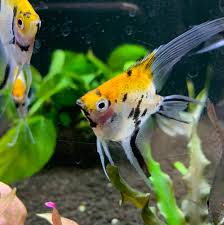1
/
trong số
1
Midwest Aquarium and Pond Supplier LLC
(30) three-color angelfish 1''
(30) three-color angelfish 1''
Giá thông thường
$5.00 USD
Giá thông thường
Giá ưu đãi
$5.00 USD
Phí vận chuyển được tính khi thanh toán.
Số lượng
Không thể tải khả năng nhận hàng tại cửa hàng
The three-color angelfish, also commonly known as a Koi angelfish or Calico angelfish, is a striking, selectively bred variant of the freshwater angelfish (Pterophyllum scalare). It is known for its distinct and beautiful combination of three primary colors: black, orange or gold, and white.
Appearance
-
Coloration: True to its name, a three-color angelfish has a marbled pattern that typically includes:
- Black: Varies in intensity and coverage, often appearing as patches or spots.
- Orange/Gold: Concentrated in the crown, or forehead, of the fish, sometimes extending to other parts of the body.
- White: A pearly or silver-white base color that highlights the other two colors.
- Fins: They have the classic angelfish shape, with long, elegant, and flowing fins that add to their graceful appearance.
- Size: Three-color angelfish can grow to a size of 6–8 inches (15–20 cm) in length.
Care and tank setup
The care requirements for a three-color angelfish are the same as for other Pterophyllum scalare varieties.
- Tank size: A minimum 30-gallon tank is recommended for a pair, with a larger tank of 55+ gallons being ideal for a community setup.
-
Water parameters:
- Temperature: 75–84°F (24–29°C).
- pH: Slightly acidic to neutral, ideally 6.5–7.5.
- Water quality: Stable and clean water is important. Perform regular partial water changes to maintain low nitrates.
- Aquascaping: A densely planted tank with driftwood, rocks, and floating plants will mimic their natural habitat. The cover helps them feel secure and can reduce aggression. A tall tank is best to accommodate their height.
Behavior and tank mates
- Temperament: Three-color angelfish are generally peaceful but can become territorial, especially during breeding.
-
Compatible tank mates:
- Other peaceful fish: Good companions include corydoras catfish, larger tetras (like diamond or black skirt tetras), and gouramis.
- Bristlenose pleco: These are good tank cleaners that will not bother the angelfish.
-
Incompatible tank mates:
- Fin-nippers: Avoid aggressive or fin-nipping species like tiger barbs, which can stress and injure the angelfish's long fins.
- Very small fish: Smaller fish, such as neon tetras, can be seen as food as the angelfish grows.
- Other angelfish: Male angelfish can be very territorial with other males. In a community tank, it is often best to keep only a single pair or a large group (6+) to disperse aggression.
Breeding
- Pairing: Angelfish will naturally form pairs within a group. It is best to purchase a group of juveniles and let them pair off naturally.
- Spawning: The breeding pair will lay eggs on a flat surface, such as a large leaf, piece of slate, or driftwood.
- Parental care: Both parents will guard the eggs and fry. They can be very aggressive during this time, so isolating the pair in a separate breeding tank is often a good practice.
Share
No reviews

